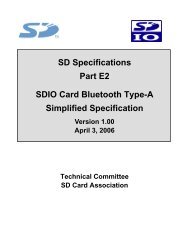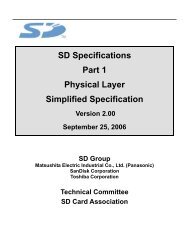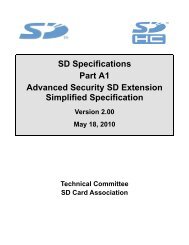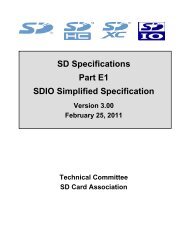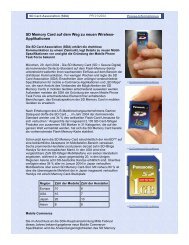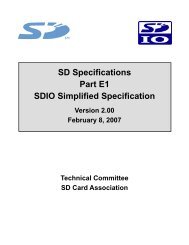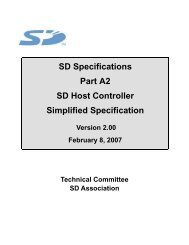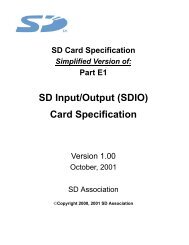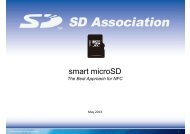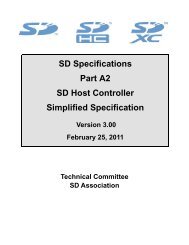SD Specifications Part 1 UHS-II Simplified Addendum - SD Association
SD Specifications Part 1 UHS-II Simplified Addendum - SD Association
SD Specifications Part 1 UHS-II Simplified Addendum - SD Association
You also want an ePaper? Increase the reach of your titles
YUMPU automatically turns print PDFs into web optimized ePapers that Google loves.
<strong>UHS</strong>-<strong>II</strong> <strong>Simplified</strong> <strong>Addendum</strong> Version 1.01©Copyright 2010-2013 <strong>SD</strong> Card <strong>Association</strong>and D1 signals are encoded by 8b/10b code before transmission, and decoded by 10b/8b afterreceiving, as described in Section 4.5.• Reference clock Lane (RCLK):RCLK is transmitted from Host to Device. Whenever Host output a RCLK to the <strong>UHS</strong>-<strong>II</strong> Device,the RCLK signal frequency and phase should be stable. The RCLK shall not be stopped and itsfrequency shall not be changed during <strong>UHS</strong>-<strong>II</strong> transmission, even within the same range. (Referto Section 4.2.2 for the Range definition and Section 6.2.3 for frequency change procedure).The RCLK frequency is lower than lowest data rate. Therefore, the Device shall generate highfrequency clock or multi-phase clocks internally for sampling the high-speed data. The RCLKfrequency is in the range of 26MHz to 52MHz; Data rate is from 390Mbps to 1.56Gbps per Lane(Refer detail in Section 4.2.2).Regarding Card, RCLK is sent through DAT0 and DAT1 lines of legacy <strong>SD</strong> interface. Thus, RCLKdoes not require additional pins. Card RCLK receiver shall be tolerant to single ended voltagerange of 0V to 3.6V DC.For power save purposes, when no data is transferred each Lane may enter EIDL state individually, orall Lanes including RCLK Lane may enter EIDL state concurrently, which is called Dormant state.During those states and mode, an Amplitude Detector of each D0, D1 Lane is active, monitoring theLine voltage and flagging wakeup notice. After detecting the wakeup notice, the detector activates PHYcircuits of own port.4.2.2 Range Definition for Data RateIn <strong>UHS</strong>-<strong>II</strong>, RCLK frequency is in the range 26MHz to 52MHz and Data rate is 390Mbps to 1.56Gbps perLane accordingly. This range is divided to two ranges for the ease of PLL design as shown in Table 4-1.Initialization of <strong>UHS</strong>-<strong>II</strong> interface after power down shall be done with the Range A.Device PLL acquisition time shall be at most 2ms. But only the first PLL acquisition time after power up,PLL of Host and Device shall finish locking less than 100ms. This is Tactivate.RCLK Frequency Data Rate/channel Ratio(Data rate / RCLKFrequency)Range A390Mbps to 780Mbps x 1526MHz to 52 MHzRange B 780Mbps to 1.56Gbps x 30Note: Even if supporting SSC, the minimum RCLK frequency shall not be lower than 26MHz.Table 4-1: Range Definition for Data Rate4.2.3 Power Supply ConnectionsTwo power supply connections are needed for <strong>UHS</strong>-<strong>II</strong> interface, named VDD1 and VDD2, for poweringthe Device by the Host.VDD1 is dedicated for powering the legacy <strong>SD</strong> interface, logic and the memory devices in the DeviceVDD2 is used for powering <strong>UHS</strong>-<strong>II</strong> interface. It should power the PHY and upper layers logic.GND node is common to all the devices and all the circuits. It is also used as reference for the <strong>UHS</strong>-<strong>II</strong>signaling levels, thus it is recommended that both Host and Device design for minimal DC variation andAC noise on this node.Section 4.2.4 to Section 4.2.7 is a blank in the <strong>Simplified</strong> <strong>Addendum</strong>.Figure 4-3: Signal Test Points16



